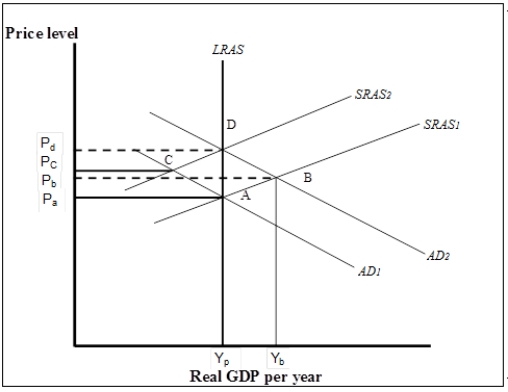Multiple Choice
Use the following to answer questions .
Exhibit: Using the Aggregate Demand/Aggregate Supply Model 1 
-(Exhibit: Using the Aggregate Demand/Aggregate Supply Model 1) Suppose the economy is initially at point A. Now suppose an increase in government purchases shifts the aggregate demand curve to AD2. Which of the following statements best explains how the economy responds to restore long-run macroeconomic equilibrium?
A) The increase in the price level to Pb reduces real GDP demanded, shifting the aggregate demand curve back to AD1, returning the economy to its potential output at A.
B) Firms produce more in anticipation of future higher prices, thus shifting the SRAS curve upward until the gap is eliminated at D.
C) Firms and workers will negotiate higher nominal wages to restore lost purchasing power. This shifts the SRAS curve to the left until the gap is eliminated at D.
D) The increase in the price level to Pb decreases consumption which in turn leads firms to cut production shifting the SRAS curve to the left until the gap is eliminated at D.
Correct Answer:

Verified
Correct Answer:
Verified
Q156: Suppose net exports decreases by $100 million
Q157: Use the following to answer questions .<br>Exhibit:
Q158: If an economy is operating at its
Q159: Suppose that an increase in government purchases
Q160: Use the following to answer questions .<br>Exhibit:
Q162: A movement along the aggregate demand curve
Q163: Wage and price stickiness<br>A) gives rise to
Q164: In the short-run, an output gap occurs
Q165: The interest rate effect suggests that the
Q166: Which of the following is a source